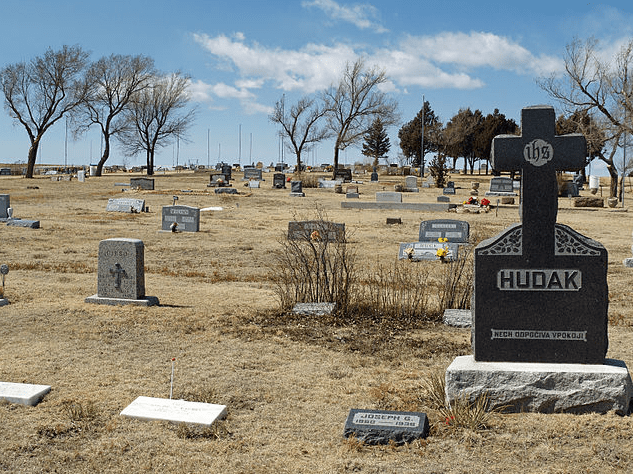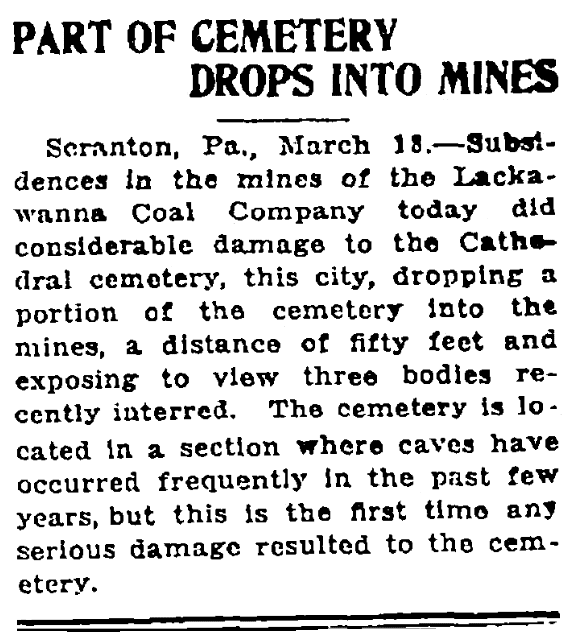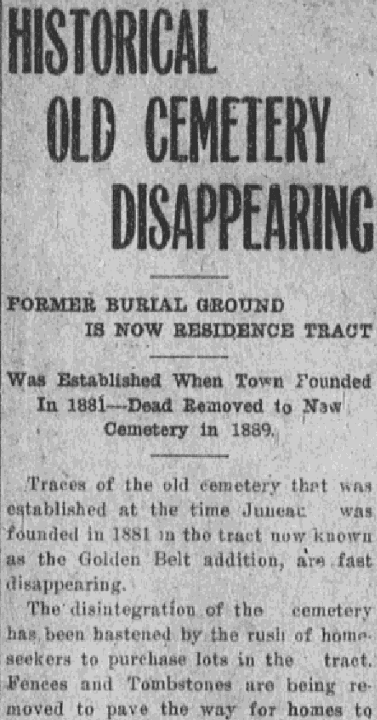Introduction: In this article, Gena Philibert-Ortega gives tips for doing cemetery research when you can’t find information about your ancestor’s burial online. Gena is a genealogist and author of the book “From the Family Kitchen.”
One of the questions I hear a lot is “why can’t I find where my ancestor is buried?” That question is usually followed up with the statement “I looked at [fill in the blank] website.” While genealogy has been greatly aided by the ability to search for our ancestors online, solely searching the Internet for a burial can quickly lead to a person believing they have a brick wall – when in reality it’s a matter of not completing an exhaustive search.

In other words: not all cemetery records are online, so you need to broaden your search. This article will give you some tips for doing that.
Why Isn’t It Online?
Burial information can be found in all kinds of places online, ranging from websites that focus on gravestone photos to those that are databases. So, if cemetery information is online, are there limitations to that information?
Yes, there are. Some of those limitations include:
- Photos and information are gathered by volunteers who may transcribe an entire graveyard, just a section, or only their ancestral burials.
- Volunteers can only transcribe/take photos of gravestones they can physically see.
- Not everyone has a tombstone.
- Not everyone is buried in a cemetery listed on a website.
- Not everyone is buried, or buried in a cemetery.
- A cemetery might have been destroyed or no longer be an active cemetery.

There are many reasons for not finding a burial listed online. Just checking a website or two is not enough. So, what should you do to conduct a more exhaustive search?
Is There a Death Certificate?
A death certificate should list where the person was buried. Now, does that mean it’s always correct? No. I’ve had situations where a cemetery is listed but the person actually was buried elsewhere, either because of a mistake on the certificate or a change of plans. I’ve also seen that at the time of the death, there was no burial – for example, the person’s body was donated to science, or the deceased was held at the morgue until the family could be contacted.
Read about It in the Newspaper
Is there an obituary? Part of an exhaustive search for information about an ancestor’s death and burial should be to check for an obituary. Not everyone has an obituary, but it’s still important to try to find one. The obituary may provide information about where the person was buried.
In some cases, the newspaper is also the best place to learn more about the cemetery. Not every cemetery still exists, so reading old newspaper articles about that cemetery might provide important clues to the history of the local cemeteries, if burials were moved, or if the cemetery is virtually “unknown” today.

Make a Call
Does the cemetery still exist and does it have an office? Make a call and ask about the burial. In one case I was researching a woman who was divorced at the time of her death, and there was no one to claim her body because all of her close family had predeceased her. After she was placed in a pauper’s section of a cemetery a close friend learned of her demise and had her body exhumed and reburied in her family’s plot, halfway across the United States. However, her friend did not buy her a tombstone. So, she’s buried in her family’s plot – but her grave is unmarked. Unless you call the cemetery, there’s no other indication of where she is buried. A photo didn’t help and she is of course not listed in online cemetery websites. A call to the cemetery office confirmed her burial and the approximate place where she was laid to rest.
Now here’s the problem: not every cemetery has an office. Cemetery records don’t always exist. And even if there is a cemetery office, that information can be lost. When researching a woman who died in the early 1900s on my paternal line, all records of her burial were lost because the cemetery office had a fire decades after her death and no effort was made to reconstruct the records. A search of the cemetery grounds also didn’t reveal her grave. The only place that lists her burial is her death certificate.
Go to the Library
Take some time to peruse library catalogs for possible cemetery histories and transcriptions. Start with a Place search on the FamilySearch Catalog for the county you are interested in, and then continue your search on the worldwide library catalog WorldCat.
Where Else Can You Find Death Information?
We’ve talked about death certificates and alternatives to death certificates in the Genealogy 101 series (see: Genealogy 101: Alternatives to Death Certificates). If you’re having a problem finding a death certificate, read that blog article for ideas on what other records might exist. In general, remember that death information may also be found in records such as:
- pensions
- wills
- probates
- land records
- funeral home records
Don’t assume that searching online cemetery records is enough. Conduct some in-depth research to find the burial information you need.
Related Articles:

My list of cemetery oddities:
After I finally located where the person was buried, I found a picture of what was left of the cemetery. The land had been returned to farming and a pile of jumbled, broken gravestones were in one big pile.
People buried on their own land.
Stories of a mass unmarked grave of 1918 flu epidemic victims.
Traced ancestor’s cemetery with the help of local historical society; found it was now a trash dumping area.
The cemetery was located via phone call and the deceased’s relative had sold the plot and we have no idea where the deceased ended up!
Bodies never recovered due to a hurricane at Galveston, Texas, and coal mine explosions.
We asked for directions to a cemetery while researching in Kentucky. The elderly gentleman in the driveway with the information — turned out it was my cousin, and I had corresponded with his wife! He and his son took us to the remote area, where the ancestors were buried, in their truck.
Thanks for that list of your experiences Carol! What I know about cemetery research is to expect the unexpected! That’s one of the reasons that genealogical research is so addicting!–Gena
During the Civil War, can you tell me if the dead soldiers’ bodies were sent home or were they buried at the place where they died? If they were buried in a cemetery where they died, how do you find out the information? Captain Joseph Cosnahan was killed during the Civil War and so was George Washington Parham. I am trying to find out what happened to their bodies. Hope you can help me; thanks.
I found a Grgrfather buried in a cemetery in Hilton Head SC He was in the Civil War
My GG Grandmother, Barbara (Eisenmann) Klein, died circa 1895, ten years after immigrating to the Bowdle, SD, area. I can’t find an account of this in any local newspaper, or county record. There are several unmarked graves where she may have been buried in a church cemetery, which lost its original records in a church fire. I have been searching unsuccessfully for her date of death since 1963.
James, that’s so frustrating . I have a similar situation and I don’t think I’ll ever find that burial. There are so many reasons why as I pointed out above. But I would suggest that you not give up hope since it’s possible some record will surface in the future. If you haven’t yet, you might want to visit the local archives. Maybe a scrapbook or a diary records her death and burial. Good luck! –Gena
Good article. They just found a very old abandoned cemetery in an apartment complex in Tampa, Florida. They are now trying to determine who owned the property and what to do now.
Wow! What a discovery Evelyn. I hope they are able to put together the history of that cemetery and a list of who is buried there. Thank you for sharing that. –Gena
Very good article, especially since many “newbies” think that everything of importance is obviously online.
I frequently receive inquiries asking the location of a “family cemetery” so that people can fit in a visit (or a photo op?) on their vacation trip to this area. Having done no personal research into the past 300 years of development near “their” ancestral home-place, they seem unable to accept that someone else has not stepped up and protected such a “sacred” property. Welcome to the real world!
Unless they have tried to contribute to the preservation of a property, or information about it, near their current residence – how can they object to the unavailability of information on a location that their relatives abandoned centuries ago?
Thanks for sharing your experience Pam. I appreciate it.–Gena
Another “clue” for a veteran’s date of death and cemetery information is a form requesting a military headstone. They usually provided a DOB, DOD, type of marker, where marker is to be shipped, sometimes name of cemetery, and the military history.
Yes, those records are wonderful. Thank you for sharing that. –Gena
My great-grandmother, Isabella (Shirley) Campbell (1843 – 1902) was buried in Mt. Moriah Cemetery, Philadelphia, PA, according to (a) her death certificate, (b) obituary notice, and (c) a letter to my grandfather who was in the U.S. Army in the Philippine Islands. The cemetery has no record of her burial. A few weeks ago, volunteers who are cutting back brush and weeds, got to the section where she is buried and posted a photo of her memorial stone on their Facebook page.
How wonderful is that! Thanks for sharing that Mary Anne, it’s so important to remember that over time not only can records be lost or destroyed but also the natural elements might take over. –Gena
What happens when the death certificate from the funerial director says they are buried at a location but are not there, and what happens to the funeral director’s records if they are no longer in business?
If the funeral home is out of business, you should ask local archives if those records were donated. I would also consider inquiring with funeral homes in the area who may have bought that business or just have been around for a long time. They may have inherited those records. Obviously, they may have also been destroyed.
I’ve had a situation where the death certificate listed a cemetery but the person was actually buried at a different cemetery. So my advice would be to check with local cemeteries to see if perhaps they were buried elsewhere. Make sure to see what cemeteries existed at the time the person died since some of those might not be active cemeteries now. Good luck–Gena
Liz, Are these Union or Confederate soldiers? For Union soldiers the Sons of the Union Veterans of the Civil War have a National Graves Registration Database . Another source is found on the National Parks Service database at https://www.nps.gov/civilwar/search-cemeteries.htm.
Have you obtained their military service file? That might provide some clues as well.
A few years ago, I was at a family member’s visitation in a county seat in Kentucky. In chatting with the funeral director, he claimed to have records from all the cemeteries in the county as well as several in neighboring counties. This included one cemetery with only 3 burials. Since my father grew up in that area, I hope to some day get back there and try to confirm some things that he told me about.
Ken, your experience is a good reminder of why it’s important to talk with locals. You never know what information they know or have access to. Thanks for sharing that! –Gena
Surprisingly (to me), not all death certificates list the actual and final place a person was buried, so that entry can be very misleading. I was told that the death certificate lists the cemetery the deceased was sent to FIRST. For instance, the death certificate for a relative I was researching said she was buried in Graceland Cemetery in Chicago. However, when I went to their office, they told me she was not buried there. They told me that if a burial was to take place in another state, people who died in Chicago were often sent to Graceland first because they had a crematorium. After that process, the remains were sent on to the final burial ground and Graceland often did not have a record of where that was. Thus, many people who have Graceland listed as their burial place are not actually buried there! It was just the first stop on the road to their final destination. I had to do further research to find my relative’s final burial spot in Wisconsin. I would not be surprised to find the same situation among other big city cemeteries across the country.
Absolutely, Aileen. I’ve had that experience as well where the death certificate lists a cemetery but it’s not the correct one. Thanks for sharing your experience. –Gena
Another “for instance”: both my grandparents are listed as being buried at a cemetery in Hayward, California; however, there are no graves for them there. On a second phone call to the cemetery, I was fortunate to connect with someone whose searched further. One of my uncles handled the arrangements for my grandparents. Apparently my two uncles and mother did not have money for burial and headstones so my grandparents were cremated and placed into a “community” building with other cremains. One of my great aunts is also in that same building.
Vikki, a great example of why if the cemetery has an office, you should talk to someone there. Unfortunately, not every cemetery is staffed but when they are, the information they can provide is invaluable. Thank you for sharing that. –Gena
When did Social Security start issuing/maintaining the SS Death Index? I have G-parents and GG-parents who lived/died in PA and NY. However, no search of official records or obits note their death. Since they were all immigrants, is it a possibility there are no “official” records from early-mid 1900s? Plan to start researching Catholic church cemeteries next!
Melissa,
The first Social Security numbers were issued towards the end of 1936. However, not everyone would have applied for a social security number. So depending on your time range, it’s very possible they didn’t have one. On top of that if no one reported their death to the Social Security Administration, you wouldn’t find them in the SSDI.
GenealogyBank’s Social Security Death Index provides some useful tips for searching.
A cousin asked me to send a copy of her parents’ marriage certificate. The date of marriage on the legal record was September 29, 1935. My cousin, the first born, was born March 23, 1936, meaning six months after the marriage. Cousin’s father died first so when her mother had a tombstone installed, she was certain to add “married May 1935.” This addition was obviously inscribed to protect honor without realizing that marriage records were readily available in 2004 when the mother died. Yes, as in all records, tombstones or otherwise, thorough research in a multitude of records is necessary.